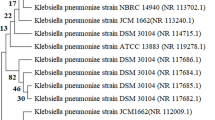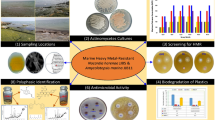Abstract
Isolation of Microorganisms capable of reducing toxic chromium (VI) into less toxic one (Cr (III)) has been given attention due to their significance in bioremediation of the contaminated sites. In the present study, Stenotrophomonas sp. Crt94-4A an isolated strain from tannery wastewater and identified genetically by 16s rRNA gene sequencing was able to grow at concentrations up to 354 mg/L of Cr (VI). The results revealed 1% (w/v) NaCl, 2% (v/v) (2 × 106 CFU) inoculum size, and PH 7 in culture containing glucose and peptone as carbon and nitrogen sources respectively were the best conditions for Cr (VI) reduction. Statistical optimization was performed using Plackett–Burman design where peptone, inoculum size, and NaCl had significant effects on Cr (VI) reduction which were tested by three factors Box-Behnken design (BBD) to determine their correlation. The reduction capacity of Cr (VI) by Stenotrophomonas Sp. Crt94-4A was increased from 82, 55, and 23 to 96, 76, and 45% at 88.5, 177 and 354 mg/L of Cr (VI) respectively, which make this strain a good candidate for bioremediation of Cr (VI).









Similar content being viewed by others
References
Abdulla HM, Kamal EM, Mohamed AH, El-Bassuony AD (2010) Chromium removal from tannery wastewater using chemical and biological techniques aiming zero discharge of pollution. In: Proceeding of Fifth Scientific Environmental Conference. Zagazig-UNI. pp. 171–183
Acosta-Rodríguez I, Arévalo-Rangel DL, Cárdenas-González JF, Moctezuma-Zárate M, Martínez-Juárez VM (2015) Hexavalent chromium (VI) removal by Penicillium sp. IA-01. Adv Bioremediat Wastewater Pollut Soil. https://doi.org/10.5772/60660
Alam MZ, Ahmad S (2012) Toxic chromate reduction by resistant and sensitive bacteria isolated from tannery effluent contaminated soil. Ann Microbiol 62(1):113–121
Alam MZ, Malik A (2008) Chromate resistance, transport and bioreduction by Exiguobacterium sp. ZM-2 isolated from agricultural soil irrigated with tannery effluent. J Basic Microbiol 48(5):416–420
APHA (2005) Standard methods of water and wastewater, 21st edn. American Public Health Association, Washington DC, pp 2–61
Bachate SP, Nandre VS, Ghatpande NS, Kodam KM (2013) Simultaneous reduction of Cr (VI) and oxidation of As (III) by Bacillus firmus TE7 isolated from tannery effluent. Chemosphere 90(8):2273–2278
Baldiris R, Acosta-Tapia N, Montes A, Hernández J, Vivas-Reyes R (2018) Reduction of hexavalent chromium and detection of chromate reductase (ChrR) in Stenotrophomonas maltophilia. Molecules 23(2):406
Barrera-Díaz CE, Lugo-Lugo V, Bilyeu B (2012) A review of chemical, electrochemical and biological methods for aqueous Cr (VI) reduction. J Hazard Mater 223:1–12
Bennett RM, Cordero PRF, Bautista GS, Dedeles GR (2013) Reduction of hexavalent chromium using fungi and bacteria isolated from contaminated soil and water samples. Chem Ecol 29(4):320–328
Bhattacharya A, Gupta A, Kaur A, Malik D (2019) Alleviation of hexavalent chromium by using microorganisms: insight into the strategies and complications. Water Sci Technol 79(3):411–424
Box GE, Draper NR (1987) Empirical model-building and response surfaces. Wiley, Hoboken
Camargo FAO, Bento FM, Okeke BC, Frankenberger WT (2003) Chromate reduction by chromium-resistant bacteria isolated from soils contaminated with dichromate. J Environ Qual 32(4):1228–1233
Cardenas-Gonzalez JF, Acosta-Rodríguez I (2010) Hexavalent chromium removal by a Paecilomyces sp. fungal strain isolated from environment. Bioinorg Chem Appl. https://doi.org/10.1155/2010/676243
Chaudhary P, Chhokar V, Choudhary P, Kumar A, Beniwal V (2017) Optimization of chromium and tannic acid bioremediation by Aspergillus niveus using Plackett-Burman design and response surface methodology. AMB Express 7(1):1–12
Cheung KH, Gu JD (2007) Mechanism of hexavalent chromium detoxification by microorganisms and bioremediation application potential: a review. Int Biodeterior Biodegrad 59(1):8–15
Dana E, Sayari A (2011) Optimization of copper removal efficiency by adsorption on amine-modified SBA-15: experimental design methodology. Chem Eng J 167(1):91–98
Das S, Ram SS, Sahu HK, Rao DS, Chakraborty A, Sudarshan M, Thatoi HN (2013) A study on soil physicochemical, microbial and metal content in Sukinda chromite mine of Odisha, India. Environ Earth Sci 69(8):2487–2497
Das S, Mishra J, Das SK, Pandey S, Rao DS, Chakraborty A, Sudarshan M, Das N, Thatoi H (2014) Investigation on mechanism of Cr (VI) reduction and removal by Bacillus amyloliquefaciens, a novel chromate tolerant bacterium isolated from chromite mine soil. Chemosphere 96:112–12142
Fernández PM, Cruz EL, Viñarta SC, De Figueroa LIC (2017) Optimization of culture conditions for growth associated with Cr (VI) removal by Wickerhamomyces anomalus M10. Bull Environ Contam Toxicol 98(3):400–406
Gadd GM (2010) Metals, minerals and microbes: geomicrobiology and bioremediation. Microbiology 156(3):609–643
Ge S, Ge SC (2016) Simultaneous Cr (VI) reduction and Zn (II) biosorption by Stenotrophomonas sp. and constitutive expression of related genes. Biotechnol Lett 38(5):877–884
He M, Li X, Liu H, Miller SJ, Wang G, Rensing C (2011) Characterization and genomic analysis of a highly chromate resistant and reducing bacterial strain Lysinibacillus fusiformis ZC1. J Hazard Mater 185(2–3):682–688
Holmes A, Vinayak A, Benton C, Esbenshade A, Heinselman C, Frankland D, Kulkarni S, Kurtanich A, Caguiat J (2009) Comparison of two multimetal resistant bacterial strains: Enterobacter. sp YSU and Stenotrophomonas maltophilia ORO2. Curr Microbiol 59(5):526–531
Ilias M, Rafiqullah IM, Debnath BC, Mannan KSB, Hoq MM (2011) Isolation and characterization of chromium (VI)-reducing bacteria from tannery effluents. Indian J Microbiol 51(1):76–81
Kathiravan MN, Karthick R, Muthu N, Muthukumar K, Velan M (2010) Sonoassisted microbial reduction of chromium. Appl Biochem Biotechnol 160(7):2000–2013
Kocaoba S, Akcin G (2002) Removal and recovery of chromium and chromium speciation with MINTEQA2. Talanta 57(1):23–30
Kumar S, Stecher G, Li M, Knyaz C, Tamura K (2018) MEGA X: molecular evolutionary genetics analysis across computing platforms. Mol Biol Evol 35:1547–1549
Kumari V, Yadav A, Haq I, Kumar S, Bharagava RN, Singh SK, Raj A (2016) Genotoxicity evaluation of tannery effluent treated with newly isolated hexavalent chromium reducing Bacillus cereus. J Environ Manag 183:204–211
Liu YG, Xu WH, Zeng GM, Tang CF, Li CF (2004) Experimental study on Cr (VI) reduction by Pseudomonas aeruginosa. J Environ Sci 16(5):797–801
Mabrouk ME (2008) Statistical optimization of medium components for chromate reduction by halophilic Streptomyces sp. MS-2. Afr J Microbiol Res 2(5):103–109
Mabrouk ME, Arayes MA, Sabry SA (2014) Hexavalent chromium reduction by chromate-resistant haloalkaliphilic Halomonas sp. M-Cr newly isolated from tannery effluent. Biotechnol Biotechnol Equip 28(4):659–667
Marsh TL, McInerney MJ (2001) Relationship of hydrogenbioavailability to chromate reduction in aquifer sediments. Appl Environ Microbiol 67:1517–1521
Moghannem SA, Farag M, Shehab AM, Azab MS (2018) Exopolysaccharide production from Bacillus velezensis KY471306 using statistical experimental design. Braz J Microbiol 49:452–462
Montgomery DC (1997) Design and analysis of experiments. Wiley, Hoboken
Pal A, Paul AK (2004) Aerobic chromate reduction by chromium-resistant bacteria isolated from serpentine soil. Microbiol Res 159(4):347–354
Pei QH, Shahir S, Raj AS, Zakaria ZA, Ahmad WA (2009) Chromium (VI) resistance and removal by Acinetobacter haemolyticus. World J Microbiol Biotechnol 25(6):1085–1093
Plackett RL, Burman JP (1946) The design of optimum multifactorial experiments. Biometrika 33(4):305–325
Pradhan SK, Singh NR, Rath BP, Thatoi H (2016) Bacterial chromate reduction: a review of important genomic, proteomic, and bioinformatic analysis. Crit Rev Environ Sci Technol 46(21–22):1659–1703
Pulimi M, Jamwal S, Samuel J, Chandrasekaran N, Mukherjee A (2012) Enhancing the hexavalent chromium bioremediation potential of Acinetobacter junii VITSUKMW2 using statistical design experiments. J Microbiol Biotechnol 22(12):1767–1775
Raman NM, Asokan S, Sundari NS, Ramasamy S (2018) Bioremediation of chromium (VI) by Stenotrophomonas maltophilia isolated from tannery effluent. Int J Environ Sci Technol 15(1):207–216
Ricou P, Lecuyer I, Le Cloirec P (1998) Influence of pH on removal of heavy metallic cations by fly ash in aqueous solution. Environ Technol 19(10):1005–1016
Saifuddin MN, Kumaran P (2005) Removal of heavy metal from industrial wastewater using chitosan coated oil palm shell charcoal. Electron J Biotechnol 8(1):43–53
Shukla OP, Rai UN (2006) Hexavalent chromium induced changes in growth and biochemical responses of chromate-resistant bacterial strains isolated from tannery effluent. Bull Environ Contam Toxicol 77:96–103
Tamura K, Nei M (1993) Estimation of the number of nucleotide substitutions in the control region of mitochondrial DNA in humans and chimpanzees. Mol Biol Evol 10:512–526
Thacker U, Madamwar D (2005) Reduction of toxic chromium and partial localization of chromium reductase activity in bacterial isolate DM1. World J Microbiol Biotechnol 21(6):891–899
Wang YT, Xiao C (1995) Factors affecting hexavalent chromium reduction in pure cultures of bacteria. Water Res 29(11):2467–2474
Wani R, Kodam KM, Gawai KR, Dhakephalkar PK (2007) Chromate reduction by Burkholderia cepacia MCMB-821, isolated from the pristine habitat of alkaline crater lake. Appl Microbiol Biotechnol 75(3):627–632
Wiegand I, Hilpert K, Hancock RE (2008) Agar and broth dilution methods to determine the minimal inhibitory concentration (MIC) of antimicrobial substances. Nat Protoc 3(2):163
Xia S, Song Z, Jeyakumar P, Shaheen SM, Rinklebe J, Ok YS, Wang H (2019) A critical review on bioremediation technologies for Cr (VI)-contaminated soils and wastewater. Crit Rev Environ Sci Technol 49(12):1027–1078
Zahoor A, Rehman A (2009) Isolation of Cr (VI) reducing bacteria from industrial effluents and their potential use in bioremediation of chromium containing wastewater. J Environ Sci 21(6):814–820
Zhang K, Li F (2011) Isolation and characterization of a chromium-resistant bacterium Serratia sp. Cr-10 from a chromate-contaminated site. Appl Microbiol Biotechnol 90(3):1163–1169
Acknowledgements
This work was financially supported by scientists for next generation (SNG) program, Academy of scientific research and technology, Cairo, Egypt.
Author information
Authors and Affiliations
Corresponding author
Additional information
Publisher's Note
Springer Nature remains neutral with regard to jurisdictional claims in published maps and institutional affiliations.
Rights and permissions
About this article
Cite this article
Shreif, O., Shehabeldine, A.M., Abu-Elghait, M. et al. Statistical optimization of chromium (VI) reduction using response surface methodology (RSM) by newly isolated Stenotrophomonas sp. (a novel strain). Biometals 35, 99–114 (2022). https://doi.org/10.1007/s10534-021-00353-6
Received:
Accepted:
Published:
Issue Date:
DOI: https://doi.org/10.1007/s10534-021-00353-6




